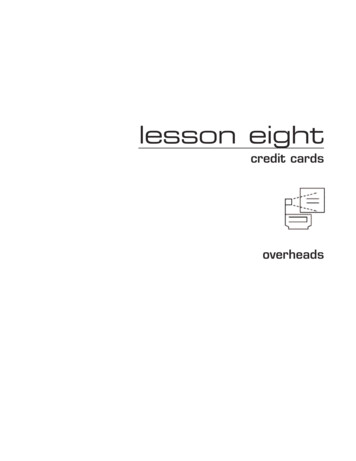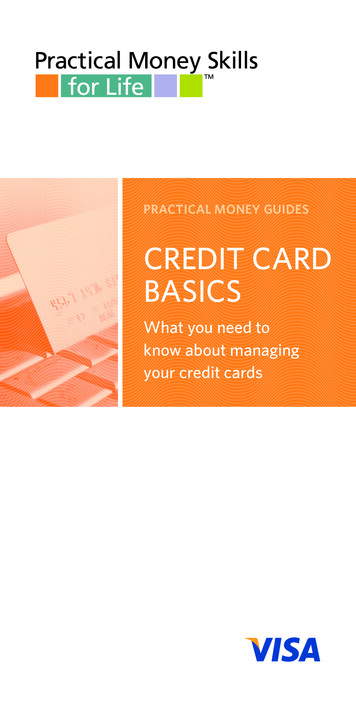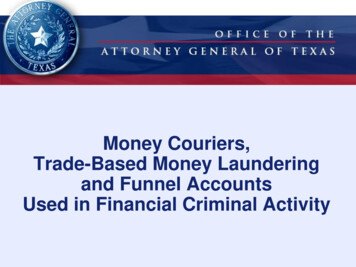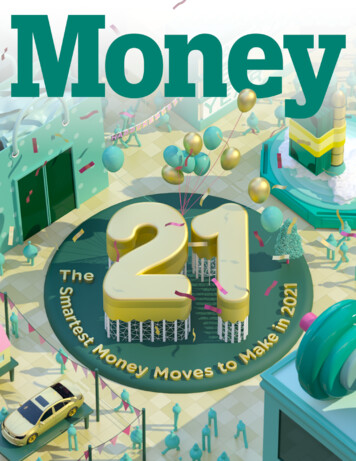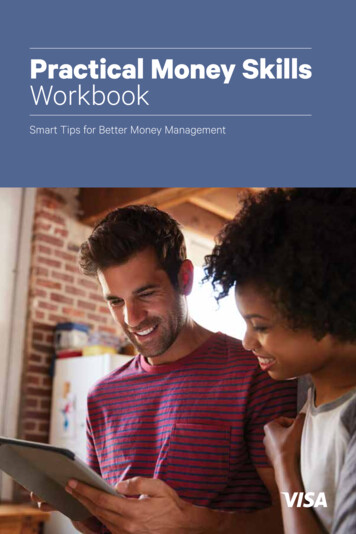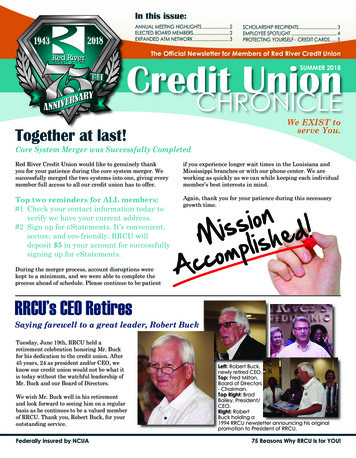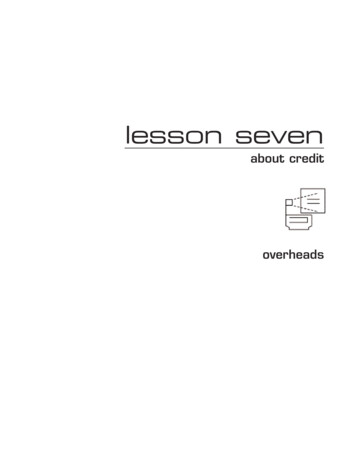
Transcription
lesson sevenabout creditoverheads
advantages and disadvantagesof using creditadvantages: Able to buy needed items now Don’t have to carry cash Creates a record of purchases More convenient than writing cheques Consolidates bills into one payment Emergenciesdisadvantages: Interest (higher cost of items) May require additional fees Financial difficulties may arise if one loses trackof how much has been spent each month Increased impulse buying may occurchoices&decisionsabout creditoverhead 7-A
the three C’scharacter — will you repay the debt?From your credit history, does it look like you possess the honestyand reliability to pay credit debts? Have you used credit before? Do you pay your bills on time? Do you have a good credit report? Can you provide character references? How long have you lived at your present address? How long have you been at your present job?capital — what if you don’t repay the debt?Do you have any valuable assets such as real estate, savings, orinvestments that could be used to repay credit debts if incomeis unavailable? What property do you own that can secure the loan? Do you have a savings account? Do you have investments to use as collateral?capacity — can you repay the debt?Have you been working regularly in an occupation that is likely toprovide enough income to support your credit use? Do you have a steady job? What is your salary? How many other loan payments do you have? What are your current living expenses? What are yourcurrent debts? How many dependents do you have?overhead 7-Bchoices&decisionsabout credit
your responsibilities Borrow only what you can repay. Read and understand the credit contract. Pay debts promptly. Notify creditor if you cannot meet payments. Report lost or stolen credit cards immediately. Never give your card number over the phone unless youinitiated the call or are certain of the caller’s identity. Never leave your credit cards unattended at work. Protect your Personal Identification Number (PIN). Don’t leave your credit cards in your vehicle. Always check your card when returned to you after a purchase. Carry your cards with you or make sure they are in a securelocation. Sign the back of a new card as soon as you get it. Make a list of all your cards and their numbers. Always check your monthly statment.choices&decisionsabout creditoverhead 7-C
your rightsconsumer protection actEnsures consumers are fully aware of their rights.human rightsProhibits discrimination in giving credit on the basis of sex, race,colour, religion, national origin, marital status, age, or receipt ofpublic assistance.credit reporting actSets up a procedure for the quick correction of mistakes that appearon consumer credit accounts.collection agencies actPrevents abuse by professional debts collectors, and applies to anyoneemployed to collect debts owed to others; does not apply to banksand other businesses collecting their own accounts.sale of goods actContract of sale between buyer and seller. Encompasses type ofcontract, enforcement provisions, duties and remedies.fair trading actApplies to consumer transactions and unfair practices that occurredafter September 1999.overhead 7-Dchoices&decisionsabout credit
building a credit history Establish a steady work record. Pay all bills promptly. Open a chequing account and don’t bounce cheques. Open a savings account and make regular deposits. Apply for a local store credit card and make regularmonthly payments. Apply for a small loan using your savings account as collateral. Get a co-signer on a loan and pay back the loan as agreed.credit bureaus Equifax (1-800-465-7166) Trans Union Local credit bureaus affiliated with these major companieschoices&decisionsabout creditoverhead 7-E
credit report — aConsumer Credit File - User Guide — Equifax Canada Inc.overhead 7-F (i)choices&decisionsabout credit
credit report — achoices&decisionsabout credit(continued)overhead 7-F (ii)
credit report — aoverhead 7-F (iii)(continued)choices&decisionsabout credit
a credit report — bchoices&decisionsabout creditoverhead 7-G (i)
a credit report — boverhead 7-G (ii)(continued)choices&decisionsabout credit
a credit report — bchoices&decisions(continued)about creditoverhead 7-G (iii)
types and sources of creditsingle-payment creditItems and services are paid for in a single payment, within a giventime period, after the purchase. Interest is usually not charged. Utility companies, medical services Some retail businessesinstalment creditMerchandise and services are paid for in two or more regularlyscheduled payments of a set amount. Interest is included. Arepayment plan is drawn up in the form of a conditional salescontract based upon fulfilling a number of conditions of the contract. Some retail businesses, such as car and appliance dealersconsumer loansMoney may also be loaned for a special purpose, with the consumeragreeing to repay the debt in regularly scheduled payments. Chartered banks Consumer finance companies Credit unions Trust companiesrevolving creditMany items can be bought using this plan as long as the totalamount does not go over the credit user’s assigned dollar limit.Repayment is made at regular time intervals for any amount at orabove the minimum required amount. Interest is charged on theremaining balance. Retail stores Financial institutions that issue credit cardsoverhead 7-Hchoices&decisionsabout credit
how much can you afford?(the 20 -10 guideline)never borrow more than 20% of your yearly net income If you earn 400 a month after taxes, then your net income inone year is:12 x 400 4,800Calculate 20% of your annual net income to find your safedebt load. 4,800 x 20% 960 So, you should never have more than 960 of debt outstanding. Note: Housing debt (i.e., mortgage payments) should not becounted as part of the 20%.monthly payments shouldn’t exceed 10% ofyour monthly net income If your take-home pay is 400 a month: 400 x 10% 40Your total monthly debt payments shouldn’t total more than 40 per month.choices&decisionsabout creditoverhead 7-I
lesson sevenabout creditstudent activities
name:date:should they use credit?directionsFor each of the following situations, circle YES, NO, or DEPENDS to indicate youropinion related to this person using credit. Also, give reasons for your response.Answers may vary.1.Gina, age 18, plans to buy a car on credit so that she is able to drive to school.YES2.NOFran and Simon recently took out a loan for a new roof.YES3.NONODEPENDSMarcia, age 28, charges all her groceries on her credit card.YES5.DEPENDSPavel, age 20, recently used his credit card to pay for textbooks for his newsemester of classes.YES4.DEPENDSNODEPENDSSandy and Carla, age 24 and 27, are planning on buying a boat on credit for use duringsummers. Carla will be the main signer for the loan, with Sandy being the co-signer.YESchoices&NOdecisionsabout creditDEPENDSactivity 7-1
should they use credit? answer keydirectionsFor each of the following situations, circle YES, NO, or DEPENDS to indicate youropinion related to this person using credit. Also, give reasons for your response.Answers may vary.1.Gina, age 18, plans to buy a car on credit so that she is able to drive to school.YES2.DEPENDSNODEPENDSMarcia, age 28, charges all her groceries on her credit card.YES5.NOPavel, age 20, recently used his credit card to pay for textbooks for his newsemester of classes.YES4.DEPENDSFran and Simon recently took out a loan for a new roof.YES3.NONODEPENDSSandy and Carla, age 24 and 27, are planning on buying a boat on credit for use duringsummers. Carla will be the main signer for the loan, with Sandy being the co-signer.YESactivity answer key 7-1NODEPENDSchoices&decisionsabout credit
name:date:test your credit knowledgeThe following questions are designed to help you remember the credit information justcovered in class.directionsIn the spaces provided, answer each of the following questions about credit.List five things you can do to build a credit history.1.2.3.4.5.When a prospective creditor evaluates a credit application, they look for the three C’s:Character, Capital, and Capacity. For each of the following statements, write the letterthat corresponds to each statement’s specific characteristic.a) Characterb) Capitalc) Capacity6.Do you have a savings account?7.Have you used credit before?8.How long have you lived at your present address?9.Do you have a steady job?10.Do you pay your bills on time?11.What are your current debts and your current living expenses?List the four major categories of information that appear on a credit report.12.13.14.15.choices&decisionsabout creditactivity 7-2a
test your credit knowledge (continued)In the space provided, write the letter of the type of credit each statement represents.a) Single payment creditb) Instalment creditc) Revolving credit16.Monthly payment on a car loan17.Monthly telephone bill18.Monthly heating bill19.Using a credit card to buy a new jacket from a department store and then payingthe charge off over several months20.Using a major credit card to buy a pair of shoes and then paying the total amountof the credit card balance within a monthFor each of the following statements, write a T in the space provided if the statementis true, and F in the space provided if the statement is false.21.It is legal for a creditor to deny an applicant credit based on marital status or age.22.If you are denied credit, the creditor is not legally obligated to explain why.23.When creditors evaluate your income, they can’t legally refuse to consider incomefrom public assistance in the same manner as other income.24.If you are refused credit because of a credit report, upon request from you, thelender must give you the name and address of the credit bureau that issued thereport.25.Your credit report is available to anyone, regardless of the reason.26.A debt collector has the right to contact you at any time of day or night.27.To be within a safe debt load, your total credit should not exceed 50% of your netpay after subtracting rent.28. What should you do if you find there is inaccurate information on your credit report?29. Generally, how long can a consumer reporting agency report unfavourable information?30. How long can bankruptcy information be reported by a consumer reporting agency?activity 7-2bchoices&decisionsabout credit
test your credit knowledge answer keyThe following questions are designed to help you remember the credit information justcovered in class.directionsIn the spaces provided, answer each of the following questions about credit.List five things you can do to build a credit history. Establish a steady work record. Pay all bills promptly. Open a chequing account and don’t bounce cheques. Open a savings account and make regular monthly payments. Apply for a small loan using your savings account for collateral and then pay it back as agreed. Get a co-signer for a loan and pay back the loan as agreed.When a prospective creditor evaluates a credit application, they look for the three C’s:Character, Capital, and Capacity. For each of the following statements, write the letterthat corresponds to each statement’s specific characteristic.a) Characterb) Capitalc) Capacity6.bDo you have a savings account?7.aHave you used credit before?8.aHow long have you lived at your present address?9.cDo you have a steady job?10.aDo you pay your bills on time?11.cWhat are your current debts and your current living expenses?List the four major categories of information that appear on a credit report.12. Identification and employment data13. Payment history14. Inquiries15. Public record informationchoices&decisionsabout creditactivity answers 7-2a key
test your credit knowledge answer keyIn the space provided, write the letter of the type of credit each statement represents.a) Single-payment creditb) Instalment creditc) Revolving credit16.bMonthly payment on a car loan17.aMonthly telephone bill18.aMonthly heating bill19.cUsing a credit card to buy a new jacket from a department store and then payingthe charge off over several months20.aUsing a major credit card to buy a pair of shoes and then paying the total amountof the credit card balance within a monthFor each of the following statements, write a T in the space provided if the statementis true, and F in the space provided if the statement is false.21.fIt is legal for a creditor to deny an applicant credit based on marital status or age.22.fIf you are denied credit, the creditor is not legally obligated to explain why.23.tWhen creditors evaluate your income, they can’t legally refuse to consider incomefrom public assistance in the same manner as other income.24.tIf you are refused credit because of a credit report, upon request from you, thelender must give you the name and address of the credit bureau that issued thereport.25.fYour credit report is available to anyone, regardless of the reason.26.fA debt collector has the right to contact you at any time of day or night.27.tTo be within a safe debt load, your total credit should not exceed 50% of your netpay after subtracting rent.28. What should you do if you find there is inaccurate information on your credit report?Contact the credit bureau. Under the Collections Practices Act, the credit bureau mustinvestigate your report.29. Generally, how long can a consumer reporting agency report unfavourable information?7 years30. How long can bankruptcy information be reported by a consumer reporting agency?Up to 10 yearsactivity answers 7-2b keychoices&decisionsabout credit
name:date:how much can they safely carry?Most people can afford a certain amount of credit and stay within a safe budget. This amount iscalled a “safe debt load.” The following exercises will give you practice determining safe debtloads based on various incomes and fixed expenses.directionsRead each of the following scenarios and determine the largest amount of debt eachperson can safely carry. Write your answers in the blanks provided. Use thespace below each question to show how you arrived at each answer.1.David has a monthly net income of 1,360. His fixed monthly expenses is a student loanpayment of 116.David would like to buy a new television set using a credit card. What is the largestmonthly payment David can afford and still be within a safe debt load?2.Francine and Pierre have a combined monthly net income of 2,700. Their fixed monthlyexpenses include 220 for Francine’s student loan payment, and 82 for the stereo theybought last month.Francine and Pierre would like to buy a new car. How much can they currently afford formonthly car payments and still maintain a safe debt load?3.Miyoshi has a monthly net income of 1,625. Her fixed monthly expenses include 68 forthe furniture she bought last month and a car payment of 167. Are Miyoshi’s expenseswithin a safe debt load?choices&decisionsabout creditactivity 7-3
how much can they safely carry? answer keyMost people can afford a certain amount of credit and stay within a safe budget. This amount iscalled a “safe debt load.” The following exercises will give you practice determining safe debtloads based on various incomes and fixed expenses.directionsRead each of the following scenarios and determine the largest amount of debt eachperson can safely carry. Write your answers in the blanks provided. Use thespace below each question to show how you arrived at each answer.1.David has a monthly net income of 1,360. His fixed monthly expenses is a student loanpayment of 116.David would like to buy a new television set using a credit card. What is the largestmonthly payment David can afford and still be within a safe debt load? 20.00 1,360 x 10% 136 136 - 116 202.Francine and Pierre have a combined monthly net income of 2,700. Their fixed monthlyexpenses include 220 for Francine’s student loan payment, and 82 for the stereo theybought last month.Francine and Pierre would like to buy a new car. How much can they currently afford formonthly car payments and still maintain a safe debt load?Francine and Pierre are already above their safe debt load and need to reduce their debt load beforebeing able to afford the car. 2,700 x 10% 270 270 - 302 - 323.Miyoshi has a monthly net income of 1,625. Her fixed monthly expenses include 68 forthe furniture she bought last month, and a car payment of 167. Are Miyoshi’s expenseswithin a safe debt load?No. 1,625 x 10% 162.50 162.50 - 235 - 72.50Right now Miyoshi is over committed and is not within a safe debt load, and she should not commit tofurther debt.activity answer key 7-3choices&decisionsabout credit
name:date:lesson seven quiz: about credittrue-false1.A disadvantage of using credit is impulse buying.2.Capital refers to a person’s assets.3.A steady employment record helps a person’s credit history.4.Instalment credit usually allows a person to make additional purchaseson an account.5.Using the 20-10 guideline, a person making 40,000 a year should have no morethan 8,000 of outstanding debt.multiple choice6.A common advantage of usingcredit is:A. less impulse buying.B. lower cost for items purchased.C. ability to obtain neededitems now.D. lower chance of overspending.9.Utility companies and medicalservice organizations commonlyoffer credit.A. revolvingB. single-paymentC. installmentD. retail7.A person’s regular income isreferred to as:A. character.B. capital.C. collateral.D. capacity.10.8.To build a credit history, aperson could:A. establish a steadyemployment record.B. file his or her federal incometaxes on time.C. use an ATM several timesa month.D. request to view her or hiscredit file.Using the 20-10 guideline, aperson earning 1,500 a monthshould not have monthly creditpayments that exceed:A. 300B. 150C. 20D. 30case applicationMakiko Nagata is considering a loan to finance her college education. She currently owesmoney on several charge accounts and credit cards. What actions would you recommend?choices&decisionsabout creditquiz 7- 4
lesson seven quiz: about credit answer keytrue-falsetA disadvantage of using credit is impulse buying.1.2.tCapital refers to a person’s assets.3.tA steady employment record helps a person’s credit history.4.fInstalment credit usually allows a person to make additional purchaseson an account.5.f7.DA person’s regular income isreferred to as:A. character.B. capital.C. collateral.D. capacity.8.ATo build a credit history, aperson could:A. establish a steadyemployment record.B. file his or her federal incometaxes on time.C. use an ATM several timesa month.D. request to view her or hiscredit file.Using the 20-10 guideline, a person making 40,000 a year should have no morethan 8,000 of outstanding debt.multiple choiceBUtility companies and medical9.CA common advantage of using6.service organizations commonlycredit is:offer credit.A. less impulse buying.A. revolvingB. lower cost for items purchased.B. single-paymentC. ability to obtain neededC. installmentitems now.D. retailD. lower chance of overspending.10.AUsing the 20-10 guideline, aperson earning 1,500 a monthshould not have monthly creditpayments that exceed:A. 300B. 150C. 20D. 30case applicationMakiko Nagata is considering a loan to finance her college education. She currently owesmoney on several charge accounts and credit cards. What actions would you recommend?While this is a valid reason for using credit, Mikiko might consider paying off some of her other debts beforetaking on this new loan. She might delay starting school full time until she has paid off herother accounts.quiz answers 7- 4 keychoices&decisionsabout credit
your responsibilities choices & decisions about credit overhead 7-C Borrow only what you can repay. Read and understand the credit contract. Pay debts promptly. Notify creditor if you cannot meet payments. Report lost or stolen credit cards immediately. Never give your card number over the phone unless you in
